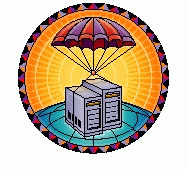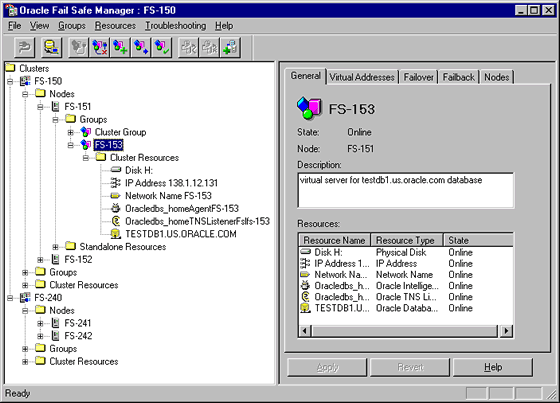- Details
Oracle Failsafe is a mostly unknown Oracle Product. I am working with this product since a short period of time, and must say it is a perfect and cheap High-Availability Solution for Oracle-Database.

"How cheap is it?"
Hmmm it costs NOTHING  you are allowed to use it if you have an oracle database. Of course, it costs you Microsoft-Licenses (Microsoft Enterprise Server) but no additional Oracle licenses.
you are allowed to use it if you have an oracle database. Of course, it costs you Microsoft-Licenses (Microsoft Enterprise Server) but no additional Oracle licenses.
"Do i need additional Database Licenses the same way i use the Oracle-RAC (Real Application Cluster)"
No, There is no additional License necessary because there is always just one Database active, read more about it in the Oracle Software Investment Guide.
"How does it work?"
Failsafe is a peace of software that takes care of your Oracle Database on a Microsoft Cluster. If one Database-Server goes down for any reason (fire, maintenance etc.) the database gets switched on an other server (called "node" in a clustered environment).
"How long does this switching take?"
It takes below an minute, we measured between 20 and 30 seconds (the listener and the database gets restarted).
Here a screenshot of how it looks like:
In this example (from the manual) you can see the Cluster FS-150 and two nodes (servers) FS-151 and FS-152.
Hee you can get more information about it:
- Details
Getting REP-56055 "Exceed max connection allowed" means check why so many connections occured at the same time, if it is normal to your environment (printing a lot of reports at 01:00 etc.) you can change following report-parameters in "...conf/rwserver.install"
<connection maxConnect="20" idleTimeOut="15">
set maxConnect to an appropriate value for your environment.
- Details
We have a very nice Java-Application at our side, and wanted to speed up the performance with the OracleDataSource (before we were working with Standard JDBC).
 So we tested a lot and the performance was slightly better in the test-environment than before.After that we went to production with it.... and the phones began to rang, the performance was BAD BAD BAD
So we tested a lot and the performance was slightly better in the test-environment than before.After that we went to production with it.... and the phones began to rang, the performance was BAD BAD BAD 
After 3 hours of analyzing of our sourcecode we had the solution:
Caching is not enabled by default (suprise surprise... by Oracle)
After adding additionals lines
<jdbc-connection-pool datasource-classname= "oracle.jdbc.pool.OracleDataSource" ...>
<property name="ImplicitCachingEnabled" value="true"/>
<property name="MaxStatements" value="190"/>
</jdbc-connection-pool>
We had an incredible speed up!
The application is now about 10 times faster than before using this DataSource. If it is possible in any case use this Datasource!
- Details
The problem is in a perl-script (db_common.pl) of the agent, that checks the disk-space and uses an old windows-function to determine how much is left.
The solution is to install a newer client (downloadable at OTN choose the "Mass Agent Deployment").

- Details
An example:
http://abc.def.com:8888/reports/rwservlet?report=c:\myreports\testreport.rdf&userid=scott/
If you are starting it in the reports-builder just choose "Distribute" from the File-Menu.
- Details
It enables you to send mails of the reports to different recipients, printers change the subject of the
mail, split the generated file by grouping (f.e. departments).
There are two ways to use "the" distribution. The first is to use the built-in property in the Report-builder.

The easier way, but within there you cannot use all features. For an exact list of the features you should take
a look at the documentation for your report-version at
http://www.oracle.com/technology/documentation/reports.html
choose the "Oracle Reports Building Reports" document.
The second-way is to use an xml-file and pass this file in the url.
Here you can download an example for such an file:
!!! Don't forget the "destination" tag, the server needs them in the documentation they are not in the examples...
- Details

After the service of my Acer N35 (connector was broken) the builtin GPS was not working. So i brought it back to Acer and they changed the antenna. I got it back and ... it was not working again.... the answer on the support-line was i shall bring it to them.
After consulting the Internet (RTFM) and a friend of mine the solution was to set the clock. After the standard-Reset the clock was reset to xx.xx.2004 and GPS needs to know the correct date and time to determine the correct sateliltes.....
- Details
A terminal-file in Forms is like a key-configuration-file in other applications. In Client-Server Mode it was set by environment or registry-variables. In Webforms you have the possibility to add it to your servlet-parameters (edit some files...) or you can put it in the formsweb.cfg the easier way.
Here a example:
[sepwin]
separateFrame=True
lookandfeel=Generic
otherparams=term=C:\oracle\FRHome_1\forms\fmrpcweb.res
- Details
If you are running on 10G and you get "ORA-00257 ORA-16020 Archiver Stuck" then you should look at the size of your flashback-area and increase it. Most of the documentation you find about this errors is about, that the disk is full, but nobody mentioned, that there is a new feature called "flashback" in 10G and that this area also can be full.
Resize the flashback-area with for example:
alter system set db_recovery_file_dest_size = 4000000000;
- Details
ORA-39002: invalid operation
ORA-39070: Unable to open the log file.
ORA-39087: directory name DATA_PUMP_DIR is invalid
There is no directory defined. You have to define it on the server.
Choose a user with the rights to create an directory, start sqlplus and enter following
command:
create directory data_pump_dir as '\exphd\datapump';
for windows...
create directory data_pump_dir as 'x:\exportdrive\datapump';
Be sure, that the directory exists on the os before you define it in the database!
- Details
check if the host you are installing has an DNS-Suffix.
If not uninstall of the server, giving a Suffix and reinstalling let the installation work
I could not find an possibility to install it without an DNS-Suffix.
- Details

![]() Some time ago i needed a forum software and took a look at the open-source-community. There were a lot of forums out there the most used is phpBB. The installation worked fine and everything was fine. The only thing was that there was no file upload/download function within the forum.
Some time ago i needed a forum software and took a look at the open-source-community. There were a lot of forums out there the most used is phpBB. The installation worked fine and everything was fine. The only thing was that there was no file upload/download function within the forum.
But after googeling around for a while i found a common mod for implementing this functionality. The installation of the mod was a damned hard thing, i had to edit about 20 files. Alternatively you could install already patched files, but the problem was that my forum was already installed and configrured, and so i would have to reconfigure it.... But after that it worked.
Some weeks after launching the forum a new version was released. Nothing big, so i followed the installations-instructions and they said that i had to reinstall all mods.... damn... the other possibility was to patch the files automatically. It took me a long time to install this patch. After some more weeks another patch was sent, and i realized that the mainenance of this forum costs a lot of time.
The next problem that occured was when my provider called me, some script tried to cheat around in my account. The vulnerability was.... phpBB... so i shut down the forum. But there were a lot of people that wanted to have access to the old messages, so i began to look to an alternative forum, and came across the Simple Machines Forum (SMF). I know this forum because Joomla, my favourite CMS is using it.
So i gave it a try, and installed it, it looked fine, easy to install easy to maintain, with the possibility to install and unistall mods automatically, very fast and very good looking :-)
And by accident i came across an migration-script from phpBB to SMF, and also gave it a try.... and could not believe it, the users, rights, threads, forums, attachments!!! were migrated and still working! My forum is up again and enhanced with several mods like a chat-mod and other nice features.
I can just recommend this software.
- Don't use timers in webforms - WHY NOT?
- The difference between PJC and Java Beans in Forms
- Forms and Reports Services Standalone
- ORA-00932: inconsistent datatypes
- Compare Database Performance
- Scott and Tiger
- Surprise Surprise Oracle Developer Suite 10gR2
- Working with Oracle Express Edition
- Oracle Express - an Oracle-Database that's for free
